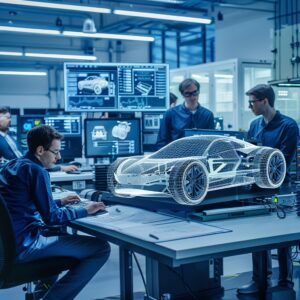EV Industry Updates
Faster growth of the EV sector underlines the improvement in technology, growing interest from the consumer segment, and policies drawn by various governments. It is essential to consider what is new in the EV sector in order to know where future transportation is heading. This article discusses some of the recent developments within the sector, important trends, and the implications of these changes on the automotive landscape.

Rising EV Adoption
Global Sale Increase
- Sales Surge: Global EV sales increased to millions per annum. In 2023, EV sales had reached a record high, showing a growing acceptance and demand for electric vehicles.
- Market Leaders: Countries like China, the United States, and European nations are at the forefront of this adoption, driven by quite encouraging policies and consumer incentives.
Gains in Battery Technology
- Solid-State Batteries: Next-generation battery technologies, such as solid-state batteries, will deliver much greater energy density, faster recharging times, and higher safety factors than what is currently available in traditional lithium-ion batteries.

- Cost Reduction: With enhancements in cell production and the materials used in these cells, the cost of a battery has drastically dropped, hence making EVs more accessible to more people.
Charging Infrastructure Expansion
- Fast Growth: The expediting development of EV charging infrastructure is all about keeping pace with the rising number of electric vehicles that hit the roads. Huge investments are being made by governments and private companies in building fast-charging networks.
- Innovative Solutions: Being developed are wireless charging and ultrafast charging technologies to make EV charging easy and convenient.
Government Policies and Incentives
Supportive Legislation
- Zero-Emission Targets: A large number of countries have put ambitious targets for zero-emission vehicle sales and have envisioned the phase-out of internal combustion engines over the next few decades.
- Incentives and Subsidies: Governments offer incentives, like tax credits, rebates, and grants to consumers in return for choosing an EV, and in general to develop the required infrastructure.
Regulatory Changes

- Emission Standards: Tighter emission standards are being created across the board, forcing OEMs to adjust their EV supply in order to remain compliant with these regulations.
- Corporate Commitments: Big investments by large car manufacturers are done in developing and producing EVs with commitments to electrify their fleets within a decade.
Recent Innovations and New Models
Continued Dominance by Tesla
- New Models: Unmatched is Tesla in the EV category, continuously offering new models like the Cybertruck and Tesla Semi, which expand the product line into non-passenger car uses. One such area of technological advancement that keeps Tesla at the forefront is the autonomous driving technology and battery innovation.
Entry of Rivian
- Electric Trucks and SUVs: Rivian entered with its electric pickup truck, the R1T, and the R1S SUV, aimed towards the niche customer segment of adventure seekers and outdoor enthusiasts.
- Innovative Features: This has innovative additions like a built-in camping kitchen in the vehicle, coupled with superior off-road ability than rivals, to its credit. Rivian’s model boasts such attributes.
EVs from Lucid Motors
A Luxury End market segment for electric vehicles.
- Lucid Air: It is a luxury electric sedan that raised eyebrows with its impressive range, performance, and features from Lucid Motors.
- Expansion Plans: New model variants will enrich the product portfolio, while several production plants will also increase their capacity to meet growing demand.
Impact on the Auto Market
Shift in Consumer Preferences
- Increasing Demand: With growing awareness regarding the environment and its benefits, more people are opting for an electric vehicle rather than a conventional fuel-based car.
- Diverse Offerings: Companies are diversifying their electric vehicle offerings to reach as many market segments as possible from compact cars and sedans to SUVs and even trucks.
Industry transformation
- New Players: EV startups like Rivian and Lucid Motors are shaking up traditional carmakers, forcing competition into the marketplace.

- Collaboration and Partnerships: Old-time auto manufacturers team up with technology companies and EV experts to expedite their quest for electric mobility.
Economic Implications
- Job Creation: The growth of the EV industry opens up new job avenues in the manufacturing sector, the research and development sector, and also in infrastructure development.
- Market Disruption: The advent of electric vehicles disrupts the automotive supply chain; affects industries linked with oil and gas; and drives investment in renewable sources of energy.

Challenges and Future Directions
Overcoming Range Anxiety
- Extended Range: With improving battery technology, increasing the range of electric vehicles has reduced one major concern of the EV buyer.
- Charging Networks: Complementing fast-charging networks and coming up with ultra-fast solutions is very desirable for allaying range anxiety.
Sustainable Production
- Environmental Impact: Ensuring that the production of EVs, from mining raw materials to the manufacturing and recycling of batteries, remains free of environmental impact is necessary for their long-term viability.
- Renewable Energy Integration: This will go a step further in reducing the environmental impact of electric vehicles to integrate renewable sources of energy such as solar and wind into the EV ecosystem.

Technological Integration
- Autonomous Driving: Autonomous driving technology could further rev up a revolution in transportation when linked to electric vehicles, making it safe, efficient, and accessible.
- Connected Vehicles: Improved connectivity and smart technology enable advanced driving experiences through features such as real-time navigation, remote diagnostics, and over-the-air updates.
Conclusion
The growth and innovation in the electric vehicle industry are fast, directly influenced by technological advancement, supporting government policies, and changing consumer preference. As the industry evolves further, there will be cleaner, more efficient, and more technologically advanced transportation solutions. Staying abreast of new developments and trends in the EV sector is important for any informed understanding of the future of mobility.
Frequently Asked Questions
- What are some of the major trends in the EV industry?
Some of the major trends in the EV industry include fast-tracked adoption of EVs, improvement in the technology of batteries, and increasing the recharging infrastructure.
- How exactly are governments helping the EV industry?
Governments are aiding the EV industry through legislation, incentives, subsidies, and setting stricter emission standards to encourage the wider adoption of electric vehicles.
- What are some of the newer innovations in the electric vehicle market?
New innovations include Tesla’s new models, Rivian’s electric trucks and sport utility vehicles, and Lucid Motors’ luxury sedans.
- How is the rise of EVs changing the automotive market?
The rise of EVs has been shifting consumer preferences, transforming the industry with new players and collaborations, and creating economic opportunities and challenges.
- What are some of the challenges the EV industry is facing in the future?
The challenges are basically triple-barreled: first, mitigating range anxiety; second, production with little detrimental effect on the environment; and lastly, the integration of cutting-edge technologies such as autonomous driving or connected vehicle features.
